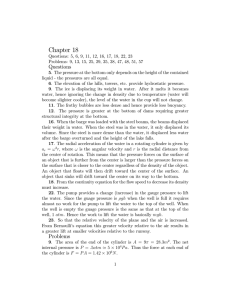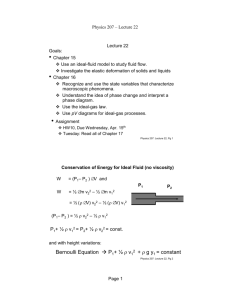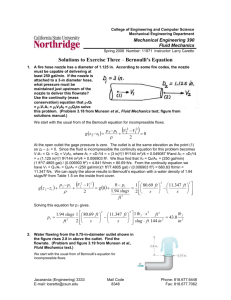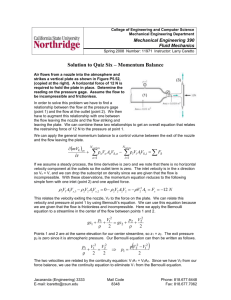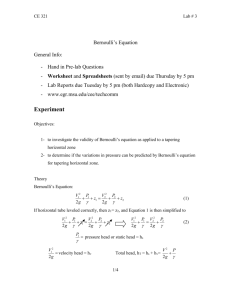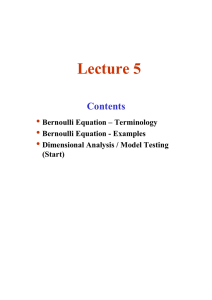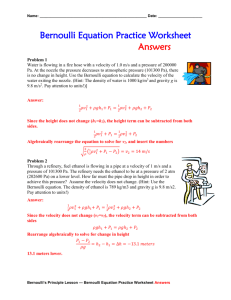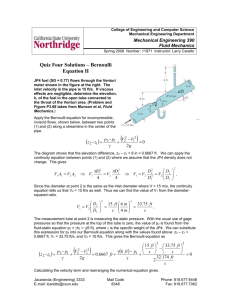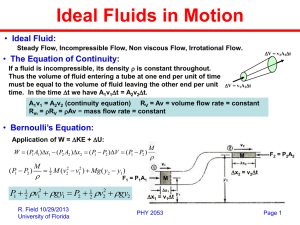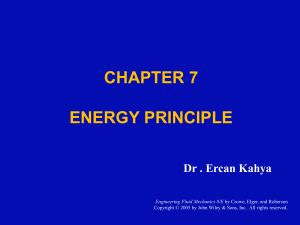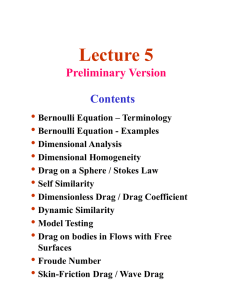CE319F Elementary Fluid Mechanics
advertisement
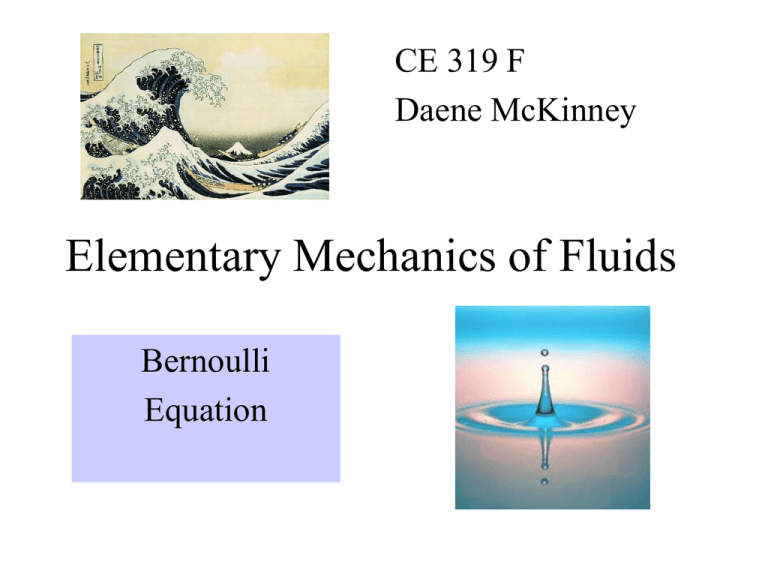
CE 319 F Daene McKinney Elementary Mechanics of Fluids Bernoulli Equation Euler Equation • • Fluid element accelerating in l direction & acted on by pressure and weight forces only (no friction) Newton’s 2nd Law Fl Mal pA ( p p ) A W sin lAal p ( p p ) l sin lal dp dz g al dl dl a d p ( z) l dl g Ex (5.1) • • Given: Steady flow. Liquid is decelerating at a rate of 0.3g. Find: Pressure gradient in flow direction in terms of specific weight. a d p ( z) l dl g dp dz al dl g dl ( 0.3g ) sin 30o g (0.3 0.5) dp 0.2 dl Flow l 30o EX (5.3) • • vertical Given: = 10 kN/m3, pB-pA=12 kPa. Find: Direction of fluid acceleration. A d p a ( z) z dz g 1 dp dz az g( ) dz dz p pB az g( A 1) 1m B 12,000 1) 10,000 a z g (1.2 1) 0 az g( (acceleration is up) HW (5.7) • Ex (5.6) What pressure is needed to accelerate water in a horizontal pipe at a rate of 6 m/s2? a d p ( z) l dl g dp dz a l dl dl dp al 1000kg / m 3 * 6m / s 2 dl dp 6000 N / m 3 dl Ex (5.10) • • Given: Steady flow. Velocity varies linearly with distance through the nozzle. Find: Pressure gradient ½-way through the nozzle ax d p ( z) dx g dp dV a x (V ) dx dx V1/2=(80+30)/2 ft/s = 55 ft/s dV/dx = (80-30) ft/s /1 ft = 50 ft/s/ft ( 1.94 slugs / ft 3 ) * (55 ft / s ) * (50 ft / s / ft ) 5,355lbf / ft 2 / ft HW (5.11) Bernoulli Equation d p 1 ( z ) at ds g 1 dV V g ds d V 2 ds 2 g d p V 2 z 0 ds 2g V2 z Constant 2g p • Consider steady flow along streamline • s is along streamline, and t is tangent to streamline p z Piezometric head V2 Velocity( dynamic) head 2g V12 p2 V22 z1 z2 2g 2g p1 Ex (5.47) Point 1 • • • Given: Velocity in outlet pipe from reservoir is 6 m/s and h = 15 m. Find: Pressure at A. Solution: Bernoulli equation V12 p A V A2 z1 zA 2g 2g p1 0 pA V A2 h 0 2g 2g 0 pA pA V A2 18 ( h ) 9810(15 ) 2g 9.81 129.2 kPa Point A Example Point 1 • • Given: D=30 in, d=1 in, h=4 ft Find: VA • Solution: Bernoulli equation V12 p A V A2 z1 zA 2g 2g p1 0 0 V A2 h 0 2g 2g 0 V A 2 gh 16 ft / s Point A Example – Venturi Tube • • • Given: Water 20oC, V1=2 m/s, p1=50 kPa, D=6 cm, d=3 cm Find: p2 and p3 Solution: Continuity Eq. V1 A1 V2 A2 A D V2 V1 1 V1 A2 d • 2 V2 p V2 z1 1 2 z2 2 2g 2g p1 p1 2 2 (V12 V22 ) [1 D / d 4 ]V12 1000 [1 6 / 34 ]22 Pa 2 p2 120 kPa 150,000 D d 2 1 Bernoulli Eq. p2 p1 D 3 Nozzle: velocity increases, pressure decreases Diffuser: velocity decreases, pressure increases Similarly for 2 3, or 1 3 p3 150 kPa Pressure drop is fully recovered, since we assumed no frictional losses Knowing the pressure drop 1 2 and d/D, we can calculate the velocity and flow rate V2 2( p1 p2 ) [1 d / D 4 ] Ex (5.48) • • • Given: Velocity in circular duct = 100 ft/s, air density = 0.075 lbm/ft3. Find: Pressure change between circular and square section. Solution: Continuity equation Vc Ac Vs As 100( D 2 ) Vs D 2 4 Vs 100( ) 78.54 ft / s 4 • Air conditioning (~ 60 oF) Bernoulli equation Vc2 ps Vs2 zc zs 2g 2g pc pc p s 2 (Vs2 Vc2 ) 0.075lbm / ft 3 pc p s (78.542 1002 ) 2 * 32.2 lbm / slug 4.46 lbf / ft 2 Ex (5.49) • • • Given: = 0.0644 lbm/ft3 V1= 100 ft/s, and A2/A1=0.5, m=120 lbf/ft3 Find: h Solution: Continuity equation V1 A1 V2 A2 V2 V1 • A1 100 * 2 200 ft / s A2 Bernoulli equation V2 p V2 z1 1 2 z2 2 2g 2g p1 p1 p2 2 (V22 V12 ) 0.0644lbm / ft 3 p1 p2 ( 2002 1002 ) 2 * 32.2 lbm / slug 30 lbf / ft 2 Heating (~ 170 oF) • Manometer equation p1 p2 h( m air ) (120 0.0644)lbm / ft 3 30 h * 32.2 ft / s 2 32.2 lbm / slug h 0.25 ft HW (5.51) Stagnation Tube V12 p2 V22 z1 z2 2g 2g p1 V12 p2 2g 2 V12 ( p2 p1 ) p1 2 ( (l d ) d ) V1 2 gl Stagnation Tube in a Pipe H p z V2 2g V2 2g p Pipe 2 Flow 1 z0 z Pitot Tube V12 p2 V22 z1 z2 2g 2g p1 p1 V12 p2 V22 2g 2g V2 2 g[( p1 z1 ) ( V 2 g ( h1 h2 ) p1 z1 ) Pitot Tube Application (p.170) V 1 z1-z2 2 p1 ( z1 z2 ) k l k y Hg (l y ) k p2 p1 p2 y ( Hg k ) ( z1 z2 ) k p1 p2 k l z1 z2 y ( Hg k ) k h1 h2 y ( Hg / k 1) V 2 gy ( Hg / k 1) 24.3 ft / s y HW (5.69) HW (5.75) HW (5.84) HW (5.93)
